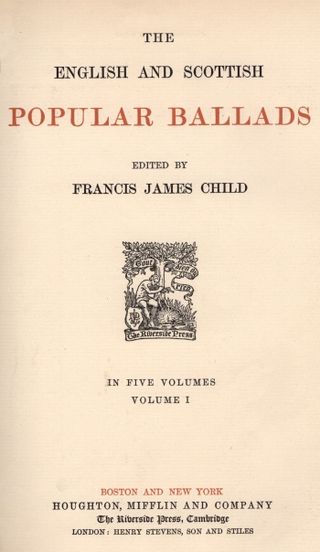"The Bonnie Earl o' Moray" is a popular Scottish ballad, which may date from as early as the 17th century.

"Matty Groves", also known as "Little Musgrave and Lady Barnard" or "Little Musgrave", is a ballad probably originating in Northern England that describes an adulterous tryst between a young man and a noblewoman that is ended when the woman's husband discovers and kills them. It is listed as Child ballad number 81 and number 52 in the Roud Folk Song Index. This song exists in many textual variants and has several variant names. The song dates to at least 1613, and under the title Little Musgrave and Lady Barnard is one of the Child ballads collected by 19th-century American scholar Francis James Child.
"Mary Hamilton", or "The Fower Maries", is a common name for a well-known sixteenth-century ballad from Scotland based on an apparently fictional incident about a lady-in-waiting to a Queen of Scotland. It is Child Ballad 173 and Roud 79.

"The Raggle Taggle Gypsy" (Roud 1, Child 200), is a traditional folk song that originated as a Scottish border ballad, and has been popular throughout Britain, Ireland and North America. It concerns a rich lady who runs off to join the gypsies (or one gypsy). Common alternative names are "Gypsy Davy", "The Raggle Taggle Gypsies O", "The Gypsy Laddie(s)", "Black Jack David" (or "Davy") and "Seven Yellow Gypsies".
"Allison Gross", also known as "Alison Cross", is a traditional folk ballad. It tells the story of "the ugliest witch in the north country" who tries to persuade a man to become her lover and then punishes him by a transformation.
"Lady Isabel and the Elf Knight" is the English common name representative of a very large class of European ballads.
"The Wee Wee Man" is an Anglo-Scottish border ballad, existing in several variants.
"The Queen of Elfan's Nourice" or "The Queen of Elfland's Nourice" is an English-language folk song, although fragmentary in form.
"Prince Robert", also known as "Lord Abore and Mary Flynn" or "Harry Saunders", is a traditional English-language murder ballad, likely originating in Scotland.

"Fair Margaret and Sweet William" is a traditional English ballad which tells of two lovers, one or both of whom die from heartbreak. Thomas Percy included it in his 1765 Reliques and said that it was quoted as early as 1611 in the Knight of the Burning Pestle. In the United States, variations of Fair Margaret were regarded as folk song as early as 1823.
The Duke of Gordon's Daughter is #237 of the Child Ballads, the collection of 305 ballads from England and Scotland, and their American variants, collected by Francis James Child in the late nineteenth century. The collection was published as The English and Scottish Popular Ballads between 1882 and 1898 by Houghton Mifflin in ten volumes and later reissued in a five volume edition.
"Sheath and Knife" is a folk ballad.
"The Broomfield Hill", "The Broomfield Wager" "The Merry Broomfield", "The Green Broomfield", "A Wager, a Wager", or "The West Country Wager" (Child 43, Roud 34) is a traditional English folk ballad.

Fause Foodrage is a Scottish murder ballad of the 17th or 18th century. It was first printed by Walter Scott in Minstrelsy of the Scottish Border (1802). Scott cited Elizabeth, Lady Wardlaw as the ballad's probable author.
The Gardener is Child ballad 219 ; also called "Proud Maisrie" or "The Gardener Child", the collection includes several variants, many fragmentary.
"The Knight and the Shepherd’s Daughter" is an English ballad, collected by Francis James Child as Child Ballad 110 and listed as number 67 in the Roud Folk Song Index.
Clerk Saunders is an English-language folk song, likely originating somewhere in England or Scotland. It exists in several variants.
Fair Mary of Wallington or Fair Lady of Wallington is a tradtional English-language folk ballad. Francis James Child lists at least seven variants of the ballad. The first variant is titled "Fair Mary of Wallington", while another variant is titled "The Bonny Early of Livingston".
The Beggar-Laddie is a traditional English ballad existing in several variants. It was collected by Francis James Child as Child ballad 280.
"The King's Dochter Lady Jean", also called "The King's Daughter," "Fair Rosie Ann," or "Queen Jane", is an English-language folk song.



